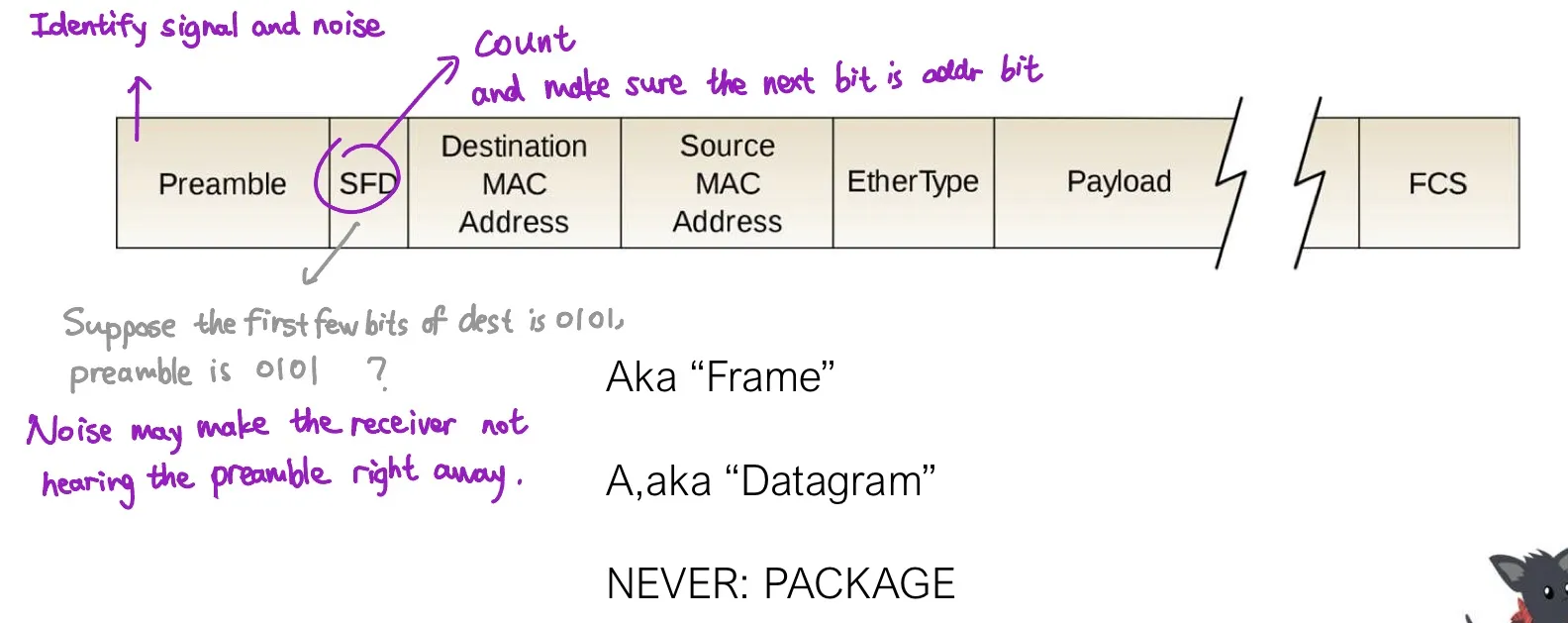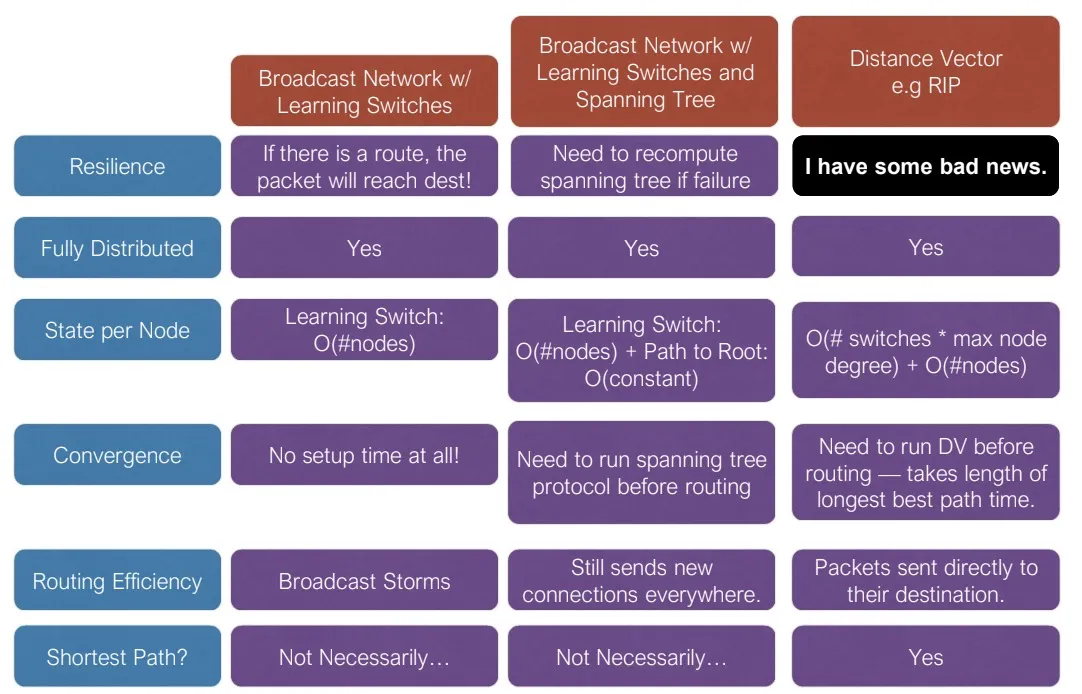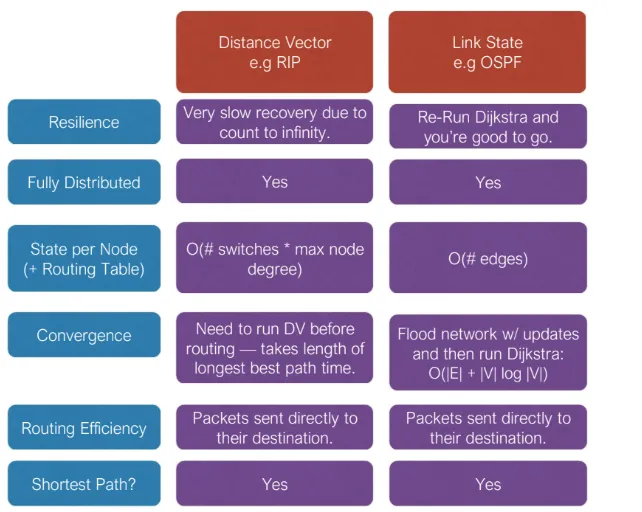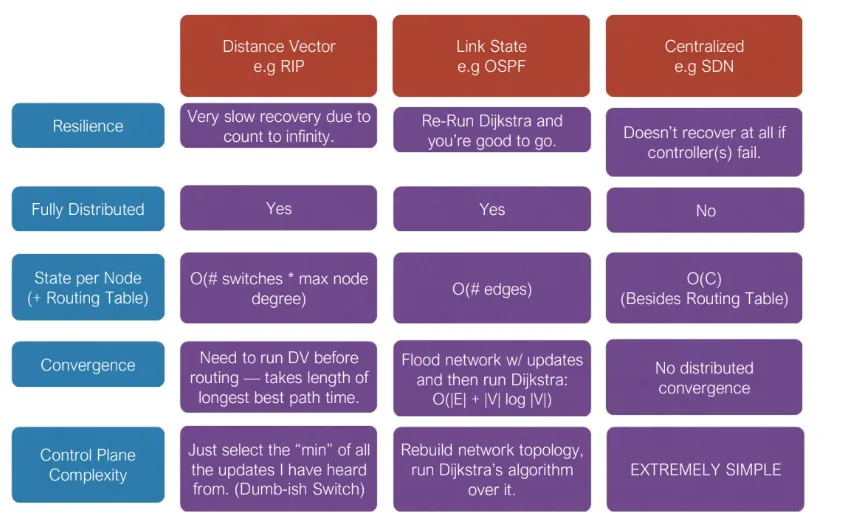[Lecture Notes] CMU 15-641 Networking and the Internet
Disclaimer: 本人没选这门课,笔记是蹭课记的,不全,不建议用作参考。
Lec 1
Propagation Delay: how long the first bit is received
Transmission Delay: how long it takes to put the remaining data
Packet Latency = Transmission Delay + Propagation Delay
Lec 3
解决多个设备同时发送/接收会冲突的问题
Solution: Random Access Protocols
- Carrier Sense: listen before you send
- Collision Detection: detect collisions and back off
- Listen while you transmit.
- If you detect another signal, stop transmitting. Ethernet has you also send a special ‘JAM’ signal to tell other listeners that the transmission has been corrupted and stopped.
- Collision Recovery: Random Exponential Backoff
- 随机等待一段时间,随着冲突次数增加,随机等待时间的抽样范围变长
- first collision: choose K from {0, 1}, delay K x 512 bit transmission times (timeslot)
- second collision: choose K from {0,1,2,3}
- 10+ collisions: choose K from {0,1, …, 1023}
- Ethernet Multiple Access Protocol (CSMA/CD)?? not used today
- Collision Avoidance: request permission to send
MAC addresses (Media access control address)
- 48-bit long. Do not have a structure (think of them as random)
Ethernet Packet

- Preamble: e.g. always 1010101010… repeating
- SFD: Start Frame Delimiter
- FCS: Frame Check Sequence (to detect errors)
Routing
- Routing, Generation 1: Broadcast
- Everybody receives the package.
- Learning Switch Algorithm
Lec 4
Spanning Tree Protocol
Distributed Spanning Tree Overview
- Embed a tree that provides a single unique path to each destination.
- Bridge with lowest ID (MAC addr) is root. 指定ID最小的人是root
- Each bridge finds and remembers the shortest path to root. 每人记住到root的最短长度和路径
- All nodes keep a simple data structure: (Root, Path Length, Next Hop)
Basic Algorithm (交流建立tree的方法)
- Assume you are the root. Store (Me, 0, Me).
- Do {
- tell neighbors (root, pathLength, yourID)
- listen to neighbors, keep getting updates … while …
- if their root ID is smaller, replace root, pathLength++
- if their root ID is same but pathLength is shorter, replace pathLength and ++
- if neighbor A and neighbor B both tell the same root, choose the shorter pathLength
Resilience: (指系统在遇到错误和挑战时还能不能保持正常功能)
Fully distributed: does not assume previous existence of a central coordinator

Distance Vector (DV)
- Each router maintains its shortest distance to every destination via each of its neighbors.
- Distance can be other value, e.g. latency.
Lec 5
Link State Algorithm
Link State:
- Everyone knows who they are connected to directly
- Everyone broadcasts a list of who they are connected to (and with link weight)
- Everyone can figure out what the entire graph is. (根据接收到的broadcast messages能推断出来)
- Everyone uses a shortest-path algorithm to find its shortest path to each destination (推断出entire graph之后使用算法找出最短路)
- DIJKSTRA算法(greedy)寻找最短路
- Everyone then builds its own forwarding table

Centralized Routing (aka Software-Defined Networking)
- Every node knows who it is connected to (和link state一样)
- All nodes tell a special controller node who they are connected to (而不是像link state一样broadcast to everyone)
- Controller computes the best routes for everyone
- Controller then tells everyone what to put in their routing tables

Fun fact: Centralized Routing is “state-of-the-art”.
Because traditional routing algorithms can’t enforce policy requirements
Lec 6.
Four Challenges 存在的问题
- 1 Each network may have distinct ways of addressing the receiver 地址格式不同
- 2 Each network may accept data of different max size 不同网络支持的最大数据包大小不同
- 4 Within each network, communication may be disrupted due to unrecoverable mutation of data or missing data 可能出现丢包等
- 5 Status information, routing, fault detection, and isolation are different (actually multiple problems)
- 3下周再讲
The Internet Protocol (IP) Addressing
对第一个问题的解决方法: Every host require an Internet Address (IP) that is distinct from its local address (e.g. MAC address). 需要一个IP地址,也就是常说的IPv4(32-bit), IPv6(128-bit)
如何获得IP地址? Using a protocol called Dynamic Host Configuration Protocol (DHCP)
如何使用IP地址?将IP地址信息也放在Ethernet header中 (放在原来payload的区域中)

如何routing?
- At the sender
- If destination D is in local network: set IP dest to D’s IP, set Ethernet dest to D’s Ethernet addr
- If destination D is outside: set IP dest to D’s IP, set Ethernet dest to my gateway’s Ethernet addr
- Gateway (aka router) looks at packages it receives on its Ethernet addresses, peeks at the IP address, and use the IP addr to determine where to send the packet.
- netmask: e.g. Gateway 34.244.91.1, netmask 255.255.255.0, means any IP address with 34.244.91.* are inside my LAN. Anything else is outside.
- At the sender
Packet Sizing
- 对第二个问题的解决方法 (IPv4中): Allow routers to ‘fragment’ packets into smaller ones
- Every link has Maximum Transmission Unit (MTU): max number of bytes of any packet
- If packet larger than MTU, router split (sent as multiple IP packets). End-point reassemble it.
- Adds complexity to IP header.
- IPv6 does not use fragmentation. Instead: If packet too big, drop it and tell the sender, and then the sender knows to send smaller packets.
Status Information, Routing, Potpourri?
- 对第五个问题的解决方法
- 解决status information: New protocol called Internet Control Message Protocol (ICMP)
- 解决routing, fault detection and isolation: 由每个network独立解决
Loss
- 对第四个问题的解决方法:Internet不保证可靠传输,instead,host自己对丢失的packet重新传输
- IP service model: 不保证will not be lost, 不保证 will not be corrupted, 不保证 will not be duplicated
The Internet Model (architecture)
五个layer,从下到上
- PHY / Physical
- LNK / Data Link
- NET / Network
- Transport
- Application